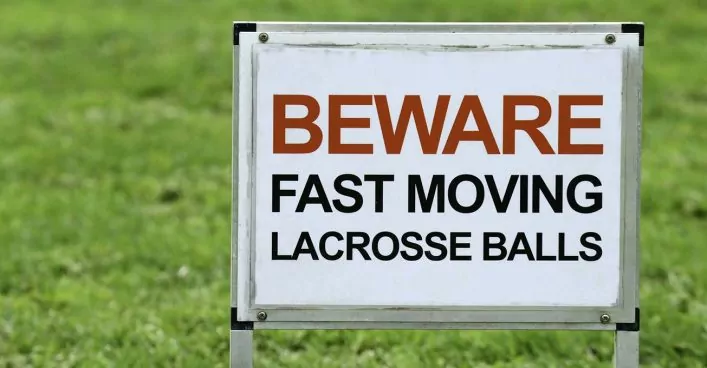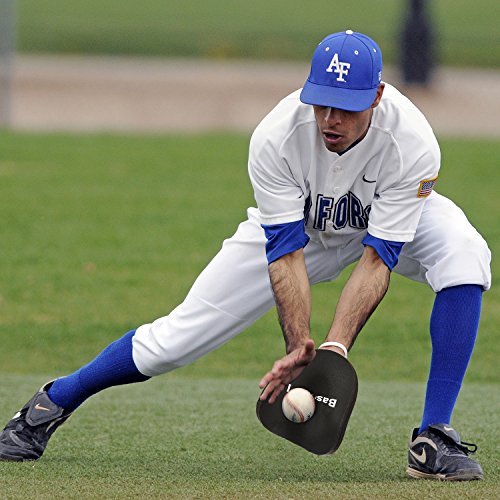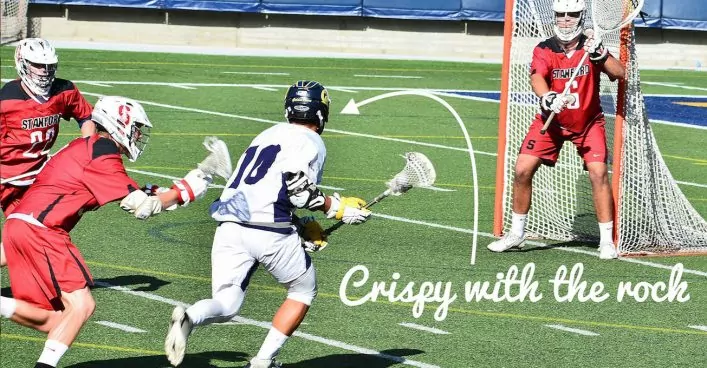What This Lacrosse Goalie Learned from Other Sports
By Coach Damon
Last updated: December 20, 2020

I played a lot of sports growing up. Soccer, baseball, tennis, wrestling, basketball, lacrosse.
And some gymnastics sprinkled in as a kid for good measure.
I’ve discussed how youth athletes should play multiple sports before so hopefully that’s no surprise.
In fact as more studies come out it’s pretty much widely accepted that focusing purely on one sport is the wrong move for youth athletes.
Because when you play different sports you learn different skills. And as it turns out some of those skills you learn directly translate into being an elite goalie.
Each sport that I played served to turn me into a well-rounded athlete.
In this post, I want to call out a few things that I learned in those particular sports that directly impacted my ability to be a great goalie when it was time to step into the crease.
Let’s go.
Baseball – Soft Hands

I started playing T-ball when I was 5 and continued to play baseball until I was 16 years old. I was an infielder, mostly 2nd base but also some shortstop and 3rd occasionally.
I then played old-man slowpitch softball with my friends for another 8 years again playing on the infield.
Soft hands are important for fielding groundballs because often times, due to a bad hop or just due to the fact that the ball was scorched, the grounder doesn’t hit your glove square in the pocket.
Those with stone hands will have those grounders pop out for an error however us soft handers field with give and transfer the energy of the ball into our arms.
Similar to a shock absorber in cars, our hands and arms have a little give which allows the scorching grounder to be controlled even if it doesn’t hit the sweet spot.
Doesn’t that sound familiar as a lacrosse goalie?
As a goalie, we also want soft hands so we can control rebounds.
You’ll find that goalies with stone hands often have their saves pop out of the stick and back into the field of play giving the offense another crack at scoring a goal.
Plus there is nothing more frustrating than making a save only to give up a rebound and quick putback goal.
In addition to soft hands, taking a lot of grounders on the infield gave me quick hands.
The San Francisco city park softball fields are notorious for poor maintenance and thus the hops infielders get are incredibly unpredictable. As an infielder in that situation, you learn quick hands so you can still get to a grounder that stays down on you when every rule of physics indicated it should have bounced up.
Nowadays a lot of goalies play with super deep pockets that help reduce rebounds but the best goalies use their soft hands on saves.
Soft-handed goalies control rebounds even on those high-velocity crank shots past 90mph. I can thank my years as a baseball infielder for the soft hands I now possess as a goalie.
Wrestling – Single Leg Takedown and Low Saves
Here is a wrestling coach demonstrating a single leg takedown in wrestling.

Here is a lacrosse goalie making a low save –

Notice any similarities there?
The fact is the movement required for a single leg takedown shares a lot in common with the movement a lacrosse goalie makes during a low save.
Our feet move quickly, our level changes, our hands explode out at the target – our opponent’s leg in one, and a lacrosse ball in the other.
Because I had years and years of experience of practicing single leg takedowns I was more prepared to master the movement required to save low shots as a goalie.
Making low saves felt more natural to me due to my years on the wrestling mat.
Wrestling/Boxing – Quick Feet

I gained quick feet from wrestling. The same skill applies to boxers although I never boxed myself.
Many of the same drills I urge lacrosse goalies to do – jump rope, magic square, agility ladder – are drills that I cut my teeth on while becoming a champion wrestler in high school.
Hours of jumping rope and practicing quick takedowns gives you quick feet.
When you have quick feet as a lacrosse goalie you can move your entire body into the shot’s path quickly and make more saves.
Wrestling and lacrosse goalies actually have a lot common in addition to needing quick feet.
I have wrestling to thank for my quick feet.
Football – Outlet passes

Throwing a football is nearly the exact same motion and footwork as throwing a good outlet pass.
With the lacrosse stick we use our bottom hand to pull on the stick so there’s a slight difference. But the footwork and rhythm are identical.
What’s also identical is how to you must lead a middie who’s streaking at an angle. You have to throw to where he’s going, not where he’s at.
I never played organized tackle football but that didn’t mean I didn’t spend a ridiculous amount of hours playing football with my friends in the courtyards of the Santa Rosa suburbs. Sometimes only stopping because it was literally too dark to see.
2×2 or 3×3 when you’re a QB you learn how to throw. How to lead the receiver and how to put touch on the pass so the receiver can make an easy catch.
Now when I practice my outlet passes in lacrosse I pretend I’m an NFL quarterback hitting a streaking wide receiver.
Learning to throw football passes helped my outlet game as a lacrosse goalie.
Basketball – Jump Stop

Moving along the crease is something that I don’t see many goalie coaches teaching.
And yet its very important. Your ability to get from one point on the arc to another point in a quick and balanced fashion can determine whether or not you make that save.
Ice hockey goalies practice moving along their arc and so should lax goalies.
Part of the technique I teach involves a jump stop (camp members – check out this training video. Not a member? Join here).
The jump stop is something I learned playing youth basketball and continued to use once I started playing goalie for my team.
When a lacrosse offense quickly swings the ball the from top left to top right, the goalie must move quickly on their arc. Many lacrosse goalies who don’t know the jump stop just can’t into position fast enough to be ready to make a save.
A well-executed pivot and jump stop get the goalie in the right place on the arc and in the proper lacrosse goalie stance – and that’s half the battle.
Basketball – Great Stance

As a youth basketball player, I prided myself on great one-on-one defense.
I was lucky enough to have great basketball coaches throughout my career and one of the first things I was taught was the proper defensive stance.
I spent hours just ensuring my stance was perfect. And also doing tons of wall sits to build up the strength in my legs to maintain that perfect stance.
As I was taught the lacrosse goalie stance I realized it mirror’s the basketball stance in so many ways.
Here’s an excerpt from this article on basketball defensive stance. See if you can spot the similarities:
The Fundamentals of a Basketball Defensive Stance
Footwork
- Both feet should be slightly wider than shoulder width apart
- With the entire foot on the ground, focus on shifting weight onto the front balls of each foot
Lower Body Position
- Knees are bent and legs are flexed
Upper Body Position
- Upper body will be slightly forward and the back remains straight
- Shoulders remain square to the offensive player [shooter]
Head and Eyes Position
- Head is up, centered in the stance and slightly over the feet
- Eyes are focused on the midsection or chest of the offensive player with the ball
Arm Position
- Arms are fully extended out to the side
Hand Position
Couple key exceptions for a lacrosse goalie stance:
- Our eyes are focused on the ball in the shooter’s stick not the midsection
- Our arms are not fully extended but bent a little in an athletic position so we can move them into the shot’s path.
Other than that, the perfect basketball defensive stance is the perfect lacrosse goalie stance.
Inside the Lax Goalie Rat online camp, members can view my lesson on the perfect goalie stance.
I owe my great goalie stance to basketball.
Tennis – Split Step

In tennis footwork, there’s a move called the split-step that helps players explode to their opponent’s shot and get into good position to make a great return shot.
When you’re facing a serve from Roger Federer or Rafa at 130mph you’ve got to get your body ready to move or else you stand no chance at a return.
Essentially when their opponent is about to hit the ball you jump up slightly (as seen in the pic of Federer above) and as soon as you land you’re exploding in either direction.
I perfected this movement while playing for my high school tennis team.
The timing can be a little tricky to master once you have it locked in, it can help you move much quicker off the mark because your legs will already be bent and loaded at the moment you recognize the direction of the ball.
I’ve worked the split-step into my lacrosse goalie game in certain situations.
That situation is when the shot is imminent. That is to say – when you know with extreme certainty that the ball carrier is going to shoot.
Shots in lacrosse can happen so quickly that the split-step preshot isn’t always appropriate but when the ballcarrier looks this the photos below, we know with extreme certainty the shot is coming.


So just like I did in tennis I’ve learned to give a subtle split-step preshot to balance my weight and get into the exact position to explode wherever that shot may go.
In my interview with John Galloway for the podcast, he credited his years of playing tennis to his classic machine gun feet preshot style of lacrosse goaltending.
As goalies, you can’t use the split-step every time as they do in tennis because of how fast the game moves and the variety of shots we need to be ready for. However, there are definitely situations that warrant a modified split-step preshot to help us make the save.
Working the split step into your lacrosse goalie game can be tricky to master but once you’ll do you’ll find it much easier to move to the shot.
I learned that playing tennis.
Conclusion
It’s a foregone conclusion that playing multiple sports is better for a kid’s athletic development. Everyone is talking about that these days.
One of the reasons is because there are specific movements and specific things you learn in some sports that translate DIRECTLY to the skills needed to be an elite lacrosse goalie.
Specifically here’s what I learned that helped me in my goalie career:
- Soft hands from baseball
- Low save technique from wrestling single-leg takedown
- Quick feet from wrestling/boxing
- Moving on the arc/Jump stop from basketball
- Stance from basketball
- Split-step from tennis
Until next time! Coach Damon
Anything you learned from another sport that’s helped you as a lacrosse goalie? Let me know in the comments down below.








 14 Amazing Lacrosse Goalie DrillsAug. 1, 2024
14 Amazing Lacrosse Goalie DrillsAug. 1, 2024 Quick Guide To Lacrosse Slang TermsApril 14, 2025
Quick Guide To Lacrosse Slang TermsApril 14, 2025 Lacrosse Goalies Rules To KnowJune 28, 2022
Lacrosse Goalies Rules To KnowJune 28, 2022 Lacrosse Goalie Step-by-Step Guide to Getting RecruitedFebruary 6, 2022
Lacrosse Goalie Step-by-Step Guide to Getting RecruitedFebruary 6, 2022 18 Lacrosse Goalie Drills to Improve Your GameApril 24, 2025
18 Lacrosse Goalie Drills to Improve Your GameApril 24, 2025 7 Elements of a Great Lacrosse Goalie StanceAug. 1, 2020
7 Elements of a Great Lacrosse Goalie StanceAug. 1, 2020 12 Lacrosse Goalie Tips To Take Your Game to the Next LevelSeptember 10, 2024
12 Lacrosse Goalie Tips To Take Your Game to the Next LevelSeptember 10, 2024 STX Eclipse 3 Goalie Head ReviewApril 24, 2025
STX Eclipse 3 Goalie Head ReviewApril 24, 2025 Lacrosse Goalie WorkoutAug. 12, 2019
Lacrosse Goalie WorkoutAug. 12, 2019 The Basics of Making a SaveJune 29, 2021
The Basics of Making a SaveJune 29, 2021









































































Honestly, basketball is a great off season sport for lacrosse. Defensively is very similar, and obviously defensive stance is the same. My old high school used to include basketball in our post conditioning sequences. I can also appreciate the use of a young Matthew Stafford for football. As a metro Detroiter, I like to imagine myself as Stafford in the pocket when I clear from the crease.
100% agree. Basketball is great off-season training for lacrosse. I was more of a Joe Montana or Steve Young guy but I liked that pic of Stafford.